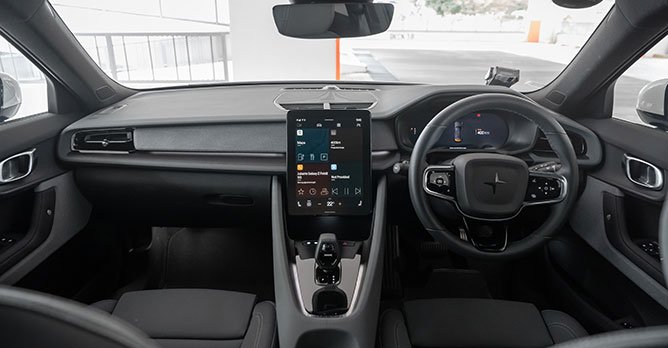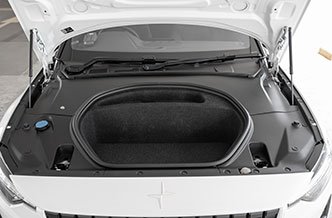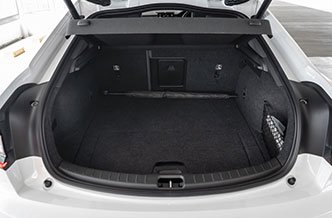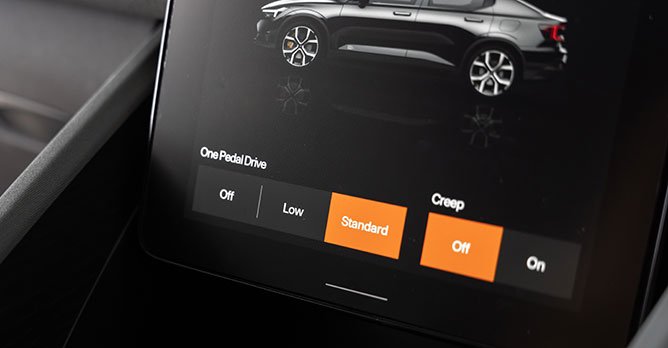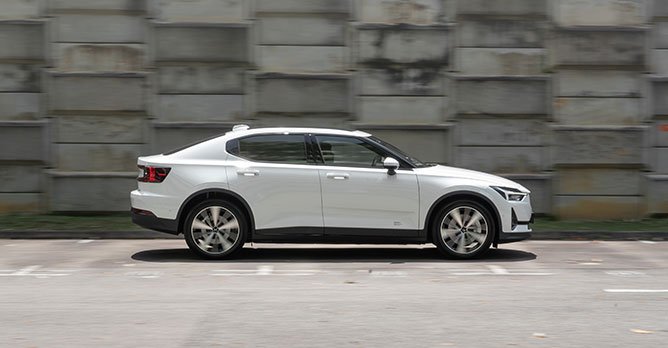Polestar 2 Electric Long Range Single Motor 78 kWh (A) Review
03 Mar 2022|7,356 views
What We Like
Design does grow on you
Scandinavian interior with high quality materials gives the car a very soothing feeling
Costs less than the dual motor variant and has better range
Cleverly integrated features abound
Managed 5km/kWh, which isn't far from the stated figure
What We Dislike
Automatic Intervention Rear Auto Brake safety feature is abrupt and inaccurate
If this car looks familiar yet slightly different to you, don't doubt yourself. You aren't seeing things and we aren't double posting.
This long range single motor Polestar 2 has the same 78kWh battery pack as its dual motor brethren that we tested some time in late December last year. While it has a significantly lower output, the all-electric car that you see here impresses on several fronts.
Space and grace
For starters, it rides very well on the standard suspension (the performance pack comes with Öhlins manually adjustable dampers that can be rather stiff, golden seatbelts as well as Brembo brakes). Thus, going over commonly experienced uneven surfaces and speed bumps is a fuss-free affair that won't send shocking shudders to the cabin.
Then there is the crisp 12.3-inch instrument cluster and the 11.2-inch centre screen that make reading and toggling easy on the go. While it'll take a while to locate and familiarise yourself with some of the functions (since most, if not all, controls are hidden within the infotainment system), the best feature I've experienced over the past three days has to be Google Maps. That's because it is seamless and identical to what you'll experience on your own smartphone.
Nevertheless, the icing on the cake has to be small but important attention to details that only a proper carmaker will be able to pull off. For instance, there is a foldable hook in the glove compartment on the passenger side that allows you to hang your packet food or drinks neatly. There are also two small storage spaces on either side of the centre console.
More impressively, there are also cleverly integrated hooks in a flip-up partition within the 405-litre boot, which make it very convenient for hanging those grocery shopping bags without worrying about their contents falling out.
Another really convenient feature is not having a start button inside the electric car. A seat sensor effectively replaces the start button. You put your foot on the brake, select Drive and you're off in silence. And when you're done, just get out of the car, lock it and walk away.
Same same but different
On the driving front, the single motor Polestar 2 sends 228bhp and 330Nm of torque to the front wheels, as opposed to 402bhp and 660Nm to all four wheels in the juicier dual motor variant. Yes, as aforementioned, there's a significant difference in terms of output figures, but the single motor Polestar 2 is thoroughly enjoyable on the go.
You do not get any driving modes in the Polestar 2, but what you do get is a comprehensive list of driving behaviour to customise to your driving style. There are three regenerative braking, three levels of steering weight as well as a creep toggle (works like an auto hold function) to suit your preference.
As with all electric cars, instant acceleration is a given. More often than not, it feels faster than the stated 7.4-second century sprint in real-life driving, certainly adequate in most situations and it makes for very easy overtaking manoeuvres. It's not super quick - not as quick as a Tesla Model 3 Standard Range - but where it lacks, the Polestar 2 manages to make up for it with its superior functional capabilities, better driving disposition and coherent sheet metal.

Less can be more
That said, more than anything, the single motor Polestar 2 is still an overall winner in my book. It may have less power on tap, but it also costs $26,000 (as of 24 February 2022) less than the dual motor variant. And in this case, costing less doesn't mean the car is any less capable.
In the market for a four-door electric sedan? Here are some other choices in this segment to consider:
The Tesla Model 3 Performance is uniquely different, with power aplenty and a clever autopilot system
The base Tesla Model 3 makes sense if you can live with one-pedal driving
The Polestar 2 Long Range Dual Motor makes a strong impression with its capable drivetrain, premium cabin and keen attention to detail
Want to see more to this capable Polestar 2? We have just the thing!
What We Like
Design does grow on you
Scandinavian interior with high quality materials gives the car a very soothing feeling
Costs less than the dual motor variant and has better range
Cleverly integrated features abound
Managed 5km/kWh, which isn't far from the stated figure
What We Dislike
Automatic Intervention Rear Auto Brake safety feature is abrupt and inaccurate
If this car looks familiar yet slightly different to you, don't doubt yourself. You aren't seeing things and we aren't double posting.
This long range single motor Polestar 2 has the same 78kWh battery pack as its dual motor brethren that we tested some time in late December last year. While it has a significantly lower output, the all-electric car that you see here impresses on several fronts.
Space and grace
For starters, it rides very well on the standard suspension (the performance pack comes with Öhlins manually adjustable dampers that can be rather stiff, golden seatbelts as well as Brembo brakes). Thus, going over commonly experienced uneven surfaces and speed bumps is a fuss-free affair that won't send shocking shudders to the cabin.
Then there is the crisp 12.3-inch instrument cluster and the 11.2-inch centre screen that make reading and toggling easy on the go. While it'll take a while to locate and familiarise yourself with some of the functions (since most, if not all, controls are hidden within the infotainment system), the best feature I've experienced over the past three days has to be Google Maps. That's because it is seamless and identical to what you'll experience on your own smartphone.
Nevertheless, the icing on the cake has to be small but important attention to details that only a proper carmaker will be able to pull off. For instance, there is a foldable hook in the glove compartment on the passenger side that allows you to hang your packet food or drinks neatly. There are also two small storage spaces on either side of the centre console.
More impressively, there are also cleverly integrated hooks in a flip-up partition within the 405-litre boot, which make it very convenient for hanging those grocery shopping bags without worrying about their contents falling out.
Another really convenient feature is not having a start button inside the electric car. A seat sensor effectively replaces the start button. You put your foot on the brake, select Drive and you're off in silence. And when you're done, just get out of the car, lock it and walk away.
Same same but different
On the driving front, the single motor Polestar 2 sends 228bhp and 330Nm of torque to the front wheels, as opposed to 402bhp and 660Nm to all four wheels in the juicier dual motor variant. Yes, as aforementioned, there's a significant difference in terms of output figures, but the single motor Polestar 2 is thoroughly enjoyable on the go.
You do not get any driving modes in the Polestar 2, but what you do get is a comprehensive list of driving behaviour to customise to your driving style. There are three regenerative braking, three levels of steering weight as well as a creep toggle (works like an auto hold function) to suit your preference.
As with all electric cars, instant acceleration is a given. More often than not, it feels faster than the stated 7.4-second century sprint in real-life driving, certainly adequate in most situations and it makes for very easy overtaking manoeuvres. It's not super quick - not as quick as a Tesla Model 3 Standard Range - but where it lacks, the Polestar 2 manages to make up for it with its superior functional capabilities, better driving disposition and coherent sheet metal.

Less can be more
That said, more than anything, the single motor Polestar 2 is still an overall winner in my book. It may have less power on tap, but it also costs $26,000 (as of 24 February 2022) less than the dual motor variant. And in this case, costing less doesn't mean the car is any less capable.
In the market for a four-door electric sedan? Here are some other choices in this segment to consider:
The Tesla Model 3 Performance is uniquely different, with power aplenty and a clever autopilot system
The base Tesla Model 3 makes sense if you can live with one-pedal driving
The Polestar 2 Long Range Dual Motor makes a strong impression with its capable drivetrain, premium cabin and keen attention to detail
Want to see more to this capable Polestar 2? We have just the thing!
Also read our comparison article on:
Polestar 2 Long Range Dual Motor (A) vs Kia EV6 GT-Line (A)Car Information
Polestar 2 Electric
CAT B|Electric|5.8km/kWh
Horsepower
170kW (228 bhp)
Torque
330 Nm
Acceleration
7.4sec (0-100km /hr)
Thank You For Your Subscription.













































